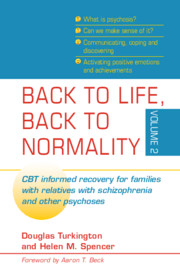 Back to Life, Back to Normality
Back to Life, Back to Normality Published online by Cambridge University Press: 16 November 2018

The following books offer CBT self-help techniques to help work towards recovery:
The following websites/links illustrate and expand on themes within this chapter: www.intervoiceonline.org/ is the international hearing voices network website which provides positive messages about hearing voices, including articles on recovery and an online community forum.
www.paranoidthoughts.com/ provides a paranoid thoughts questionnaire, personal accounts of paranoia and advice about coping with paranoia.
www.ted.com/speakers/eleanor_longden Eleanor Longden talks about her recovery journey with an encouraging message for those who hear voices.
www.youtube.com/watch?v=0nnekxGE0nM is a four-minute YouTube clip that demonstrates how quickly hallucinations and paranoia can be induced in anyone within 48 hours.
www.bps.org.uk and search for the ‘understanding psychosis and schizophrenia’ PDF, which offers a comprehensive overview of the current state of knowledge in the field.
www.mindfulnessmuse.com/wp-content/uploads/2011/09/Cognitive-Defusion-Exercise-1.pdf offers a script to use for the ‘leaves on a stream’ exercise.
More examples and discussion of positive experiences of beliefs are available in Chapter 3.
Further advice on techniques that can help with recovery are illustrated in Chapters 5, 7, and Chapters 12–14.
More detailed examinations of particular experiences such as ‘delusions’, hearing voices and visions are provided in Chapters 9–11.
To save this book to your Kindle, first ensure no-reply@cambridge.org is added to your Approved Personal Document E-mail List under your Personal Document Settings on the Manage Your Content and Devices page of your Amazon account. Then enter the ‘name’ part of your Kindle email address below. Find out more about saving to your Kindle.
Note you can select to save to either the @free.kindle.com or @kindle.com variations. ‘@free.kindle.com’ emails are free but can only be saved to your device when it is connected to wi-fi. ‘@kindle.com’ emails can be delivered even when you are not connected to wi-fi, but note that service fees apply.
Find out more about the Kindle Personal Document Service.
To save content items to your account, please confirm that you agree to abide by our usage policies. If this is the first time you use this feature, you will be asked to authorise Cambridge Core to connect with your account. Find out more about saving content to Dropbox.
To save content items to your account, please confirm that you agree to abide by our usage policies. If this is the first time you use this feature, you will be asked to authorise Cambridge Core to connect with your account. Find out more about saving content to Google Drive.